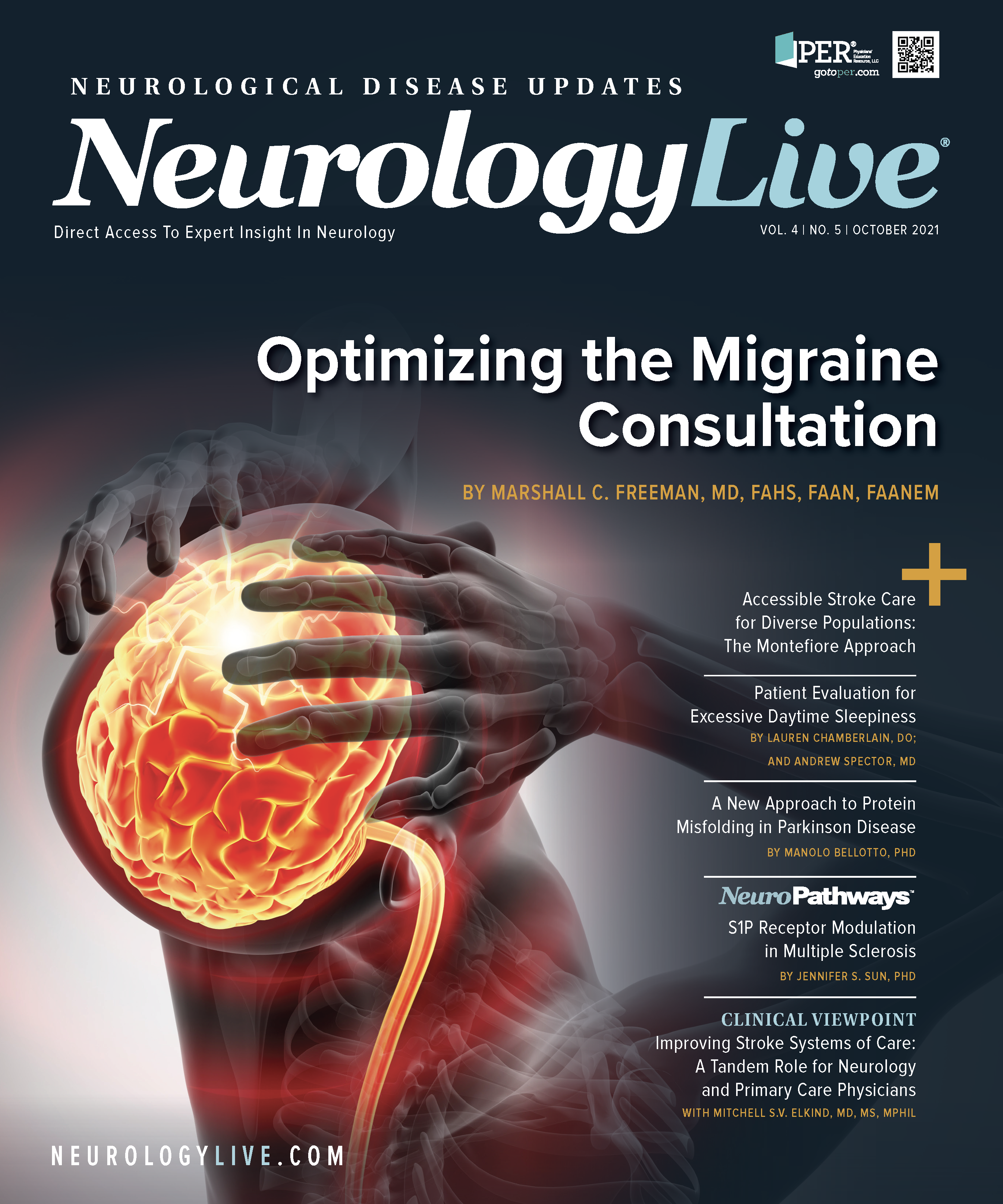Publication
Article
NeurologyLive
Optimizing the Migraine Consultation
Proper diagnosis and effective treatment planning can drastically improve quality of life for individuals with migraine.
Marshall C. Freeman, MD, FAHS, FAAN, FAANEM

ACCORDING TO THE World Health Organization Global Burden of Disease Study (2019), migraine is the second-highest cause worldwide for years lived with disability (YLD) among all ages, as well as the greatest cause of YLD for individuals aged 15 to 49 years.1,2 Up to 1 billion individuals worldwide experience migraine,3 and direct and indirect costs of migraine are estimated to range from $28 billion to $36 billion annually in the United States alone.3,4 Statistical regression modeling has estimated missed workdays due to migraine (absenteeism) at 1 to 2 days and lost productivity (presenteeism) at 2 to 5 days monthly depending on episodic or chronic migraine status,4 with high-end estimates predicting nearly $6500 of lost productivity yearly per individual affected with chronic migraine.5
Diagnosing and treating migraine correctly yields substantial benefits to the individual, family, and community. This review will provide an abbreviated approach to the migraine patient consultation, highlighting key clinical strategies that can enhance the management of patients with migraine.
Making the Diagnosis
Determine whether the patient has a primary or secondary headache. Practitioners can screen for secondary headaches using the acronym SNOOP.6 In its simplest form, SNOOP provides a broad differential diagnosis for secondary headaches: systemic symptoms/secondary risk factors, neurological signs or symptoms, onset (temporal qualities), older age of onset, and prior headache history. Red flags of the medical history include malignancy, immunosuppression, HIV/AIDS, pregnancy, fever, or weight loss; sudden, rapidly escalating or exploding head pain occurring spontaneously or with exertion (including thunderclap headache); later age of onset (> 50 years) for those without a prior history of headaches; and unusual or atypical head pain for individuals with known prior headaches. Red flags of the physical examination include impaired mental status, abnormal cranial nerve findings (including pupillary, eye movement, or visual field abnormalities), papilledema, temporal artery tenderness, and focal weakness.
Conditions that cause secondary headaches include tumors (including those of the posterior fossa), metastatic disease, brain abscess, encephalitis, subarachnoid hemorrhage, venous sinus thrombosis, idiopathic intracranial hypertension, low cerebrospinal fluid pressure headache, reversible cerebrovascular syndrome, stroke, and temporal arteritis. While complex neurological disorders with associated headaches do exist, distinguishing migraine from the above disorders can be achieved by careful attention to the differences in onset and exam findings.
Imaging is not indicated for migraine. The American Headache Society (AHS) has published guidelines for imaging in migraine.7 Many patients with migraine present with a typical medical history that can fulfill International Classification of Headache Disorders, third edition (ICHD-3) diagnostic criteria for diagnosis of migraine and normal results of physical examination. Routine use of imaging leads to unnecessary use of medical resources and higher societal medical costs. Incidental findings may lead to unhelpful and expensive further work-up and an increase in patient anxiety.7 For patients with headache with atypical features, MRI is the recommended imaging study over CT.7
Migraine is a diagnosis which requires taking a good history of the disease. There are currently no diagnostic laboratory tests or imaging studies in clinical practice that establish the diagnosis of migraine. The ICHD-3 provides guidance on the diagnosis of all migraine types, including migraine without aura, migraine with aura, chronic migraine, and multiple migraine subtypes that are beyond the scope of this article.8
ICHD-3 defines migraine without aura as a recurrent headache disorder with attacks lasting from 4 to 72 hours untreated. Two of the following 4 elements should be present: (1) unilateral location, (2) pulsating quality, (3) moderate or severe pain intensity, and (4) aggravation by or causing avoidance of routine physical activity. Additionally, 1 of the following 2 elements should be present: (1) nausea and/or vomiting, and (2) photophobia and phonophobia. These guidelines allow for a broad inclusion of individuals experiencing headache to be given a diagnosis of migraine. Importantly, no single element is required for a diagnosis of migraine. An individual with migraine may lack nausea or vomiting or throbbing pain or unilateral location and still fulfill the ICHD-3 definition for migraine. A patient with bilateral nonpulsatile headache may have migraine if the other elements are present. Many patients receive misdiagnoses of other headache types because clinicians are unaware of the ICHD-3 criteria or are using the criteria incorrectly.
Treatment Decisions
The general neurologist or provider should treat migraine principally using evidence-based on-label therapies. As there are now numerous FDA-approved products for both acute and preventive treatments, practitioners can now use targeted therapy. Off-label medication use should be limited. While the provider should be sensitive to patient comorbidities, do not substitute inferior medications for the sole purpose of treating multiple ailments.
A headache calendar is an essential tool and the gold standard to determine whether a patient has episodic migraine (≤ 14 headaches per month) or chronic migraine (≥ 15 headaches per month). Headache calendars provide an accurate measure of headache frequency and allow providers to determine whether other meaningful patterns exist, such as weekend-related headaches or those related to menstruation. Patients can track headache activity with paper or phone-based applications. During the initial interview, the provider should ask the patient to estimate the number of pain-free days experienced each week, as many patients routinely underestimate the number of headache days they experience. It is the author’s observation that many patients commonly underreport headache frequency because many events have become chronic or mild in intensity, lack the most burdensome migraine qualities, or have been suppressed by over-the-counter (OTC) medications.
Preventive Treatments
Preventive treatment management should take priority over abortive treatment management. Effective prevention reduces migraine frequency, migraine severity, and migraine duration; reduces prolonged or disabling aura attacks; reduces likelihood of status migrainosus; and may improve effectiveness of acute treatments. Focusing on prevention also reduces the risks of acute treatment pitfalls, especially medication-overuse headache (MOH) with prescription and OTC medications.
The AHS and the American Academy of Neurology have jointly published evidence-based guidelines for migraine prevention.9 Level A (established efficacy) medications include topiramate, divalproex sodium, sodium valproate, metoprolol, propranolol, and timolol; level B (probably effective) medications include amitriptyline, venlafaxine, atenolol, and nadolol. Newer FDA-approved products that would be included under level A efficacy include onabotulinumtoxinA (Botox; Allergan) for chronic migraine and the calcitonin gene-related peptide (CGRP) medications erenumab (Aimovig; Amgen/Novartis), fremanezumab (Ajovy; Teva Pharmaceuticals), galcanezumab (Emgality; Eli Lilly and Company), and eptinezumab (Vyepti; Lundbeck Seattle BioPharmaceuticals). Rimegepant (Nurtec ODT; Biohaven Pharmaceuticals), a small molecule CGRP ligand antagonist, is indicated for both the acute and preventive treatment of migraine. Select FDA-approved neuromodulating therapies for prevention include noninvasive vagus nerve stimulator (gammaCore Sapphire; electroCore, Inc), single-pulse transcranial magnetic stimulation (sTMS) mini, and transcutaneous supraorbital nerve stimulation (Cefaly Dual) devices.
Avoid polypharmacy and stacking preventive medications. Rather, use a single preventive medication to its maximum tolerable dose to determine its efficacy and then change to a different product if needed. Successful treatment outcomes for preventive medications in migraine are a 50% reduction in mean headache days.10 Begin medications at a low dose and titrate slowly to improve tolerability. Discontinue a medication that demonstrates only incomplete benefit in favor of a new medication trial. Returning to the original medication is always possible if the subsequent choice is less effective. Avoiding polypharmacy reduces potential adverse effects, improves adherence, and reduces cost. The strategy of combining medications solely because they may have different mechanisms of action is not supported at this time because the definitive mechanism of action for migraine is unknown for most commonly used preventive treatments (with the exception of the newest CGRP medications).
Providers should regularly evaluate treatment effectiveness for preventives. Many patients will return to the clinic stating their therapies are not working. Interview patients carefully to define the cause of a treatment failure, and avoid rushing to switch treatments. Failure may be related to zero efficacy, incomplete efficacy, inadequate dose, inadequate trial period, medication tolerability, presence of medication overuse, nonadherence, incomplete treatment of associated comorbid conditions, or unreasonable patient (or physician) expectations. Set reasonable expectations with patients at the onset of therapy to reduce patient and provider dissatisfaction. Most medication failures can be salvaged by identifying the issue and adjusting the approach.
Both patient and provider should be aware of medication trial periods needed for effectiveness. Oral products may require 2 to 3 months of use to determine efficacy, whereas newer CGRP medications may take 3 to 6 months. Personal experience suggests onabotulinumtoxinA may take up to 3 treatments performed quarterly to determine effectiveness. Failure or intolerance of 1 medication in a single category is not a failure of the entire category. It is acceptable to try other medications in the same family of products.
Acute Treatment
Finding the most effective acute antimigraine treatment may take multiple attempts. Practitioners should individualize medications for the patient. A detailed history including the patterns of headache, time of onset, presence of nausea or vomiting, and occurrence of rapidly escalating pain should be elicited. Antimigraine agents are currently available in tablets, oral dissolving tablets, nasal sprays, nasal powders, and injectable formulations. Patients with significant nausea or vomiting should be prescribed nasal or injectable treatments to bypass impaired gastrointestinal absorption; likewise, patients with rapidly escalating migraine attacks should preferentially use nasal sprays or injections because of better early efficacy and faster onset compared with oral therapies.
Triptan medications remain the first-choice treatment for many patients with migraine (eg, sumatriptan, zolmitriptan, rizatriptan, etc). Triptans are effective, well tolerated, typically non-sedating, readily available, and low cost. Avoid prescribing different triptans to the same patient concomitantly (eg, sumatriptan plus rizatriptan) because of risks of triptan-to-triptan contraindications and medication overuse headache (MOH); however, it is ideal to prescribe different formulations of the same triptan (sumatriptan injection plus sumatriptan tablets), which the patient can then select preferentially for acute attacks. Both sumatriptan and zolmitriptan are available in multiple formulations.
A subset of patients with migraine may have triptan contraindications (including cardiovascular or cerebrovascular) or triptan intolerances. These patients may be candidates for the newer branded CGRP medications. Avoid opioids and butalbital-containing medications. Neuromodulation for the acute treatment of migraine is currently underused. On-label acute options include the gammaCore, sTMS mini, Cefaly Dual, Nerivio, and Relivion devices. The role of neuromodulation for both acute and preventive treatment is still developing.
Medication overuse is a significant contributor to migraine disability. The ICHD-3 defines MOH as a primary headache that, in association with medication overuse, progresses to a new type of headache or a significant worsening of the preexisting headache.8 Patients with MOH experience greater migraine frequency and burden than those with controlled acute medication usage. MOH (formerly known as rebound headache) can develop from regular intake of any combination of ergotamines, triptans, combination analgesics, or opioids over a total of 10 or more days per month for more than 3 months.
MOH can develop from regular intake of acetaminophen, acetylsalicylic acid, nonsteroidal anti-inflammatory drugs, and other analgesics over a total of 15 or more days per month for more than 3 months.8 Data from the American Migraine Prevalence and Prevention Study demonstrated that opioid use for as few as 8 days per month and butalbital-combination medication use for greater than 4 days per month were sufficient to cause MOH and progression to chronic migraine.11 Comprehensive studies are not currently available to determine the risk of MOH with newer CGRP products, such as rimegepant, ubrogepant (Ubrelvy; AbbVie), or other forthcoming medications.
Patients who switch among various oral products are not protected against MOH either. MOH can develop from overuse of combination categories. Avoid prescribing multiple triptans, multiple acute CGRP ligand antagonists, opioids, butalbital, or similar medications to an individual patient. Teach patients to be selective in managing attacks. Treating attacks early provides the best efficacy.12 Treating early also reduces the likelihood of requiring additional doses of medication or requiring rescue treatment. Not every headache requires oral medication. Patients with high-frequency attacks may use non-oral options, such as topical ointments or salves, massage, relaxation exercises, and possibly neuromodulation. Prioritize prevention over abortive treatment.
Comorbidities and Lifestyle Management
Proper migraine treatment requires acknowledgment and management of comorbid disorders and unhealthy lifestyle choices. Migraine is comorbid with dozens of psychiatric, neurologic, pain, and medical conditions, including depression, anxiety disorder, bipolar disorder, panic attacks, epilepsy, insomnia, sleep apnea, restless leg syndrome (RLS), fibromyalgia, obesity, stroke, and myocardial infarction.13,14
In many circumstances, the neurologist may be the first provider to formally identify sleep disorders. Testing for sleep apnea, RLS, and other sleep conditions should be pursued. Modifiable elements should be targeted, such as addressing shift-work hours, unregulated sleep times involving the weekends, and poor sleep environments populated by televisions and cell phones. When appropriate, the focus should be on introducing behavioral treatments before medications.
Obesity is an epidemic in the United States,15 with a prevalence of 42.4% in 2017-2018, with non-Hispanic Black adults having the highest age-adjusted prevalence of obesity at 49.6%.16 Obesity is a risk factor for migraine and is associated with an increase in migraine attack frequency and severity,17 from episodic migraine to chronic migraine.18 Honest discussions with patients with obesity who have migraine are beneficial. Removing processed and high-calorie foods reduces obesity risk. Referral to a nutritionist may be helpful.
Other areas of lifestyle modification appropriate for discussion include tobacco use, smoking, vaping, sedentary behavior, stress management, caffeine use, soda and other beverage consumption, and chronically poor nutritional choices.
In summary, a treatment approach that diagnoses correctly, uses evidence-based therapies, limits polypharmacy, and actively identifies and manages comorbid conditions will increase the likelihood of successful outcomes for patients with migraine.
REFERENCES
1. Steiner TJ, Stovner LJ, Jensen R, Uluduz D, Katsarava Z. Migraine remains second among the world’s causes of disability, and first among young women: findings from GBD2019. J Headache Pain. 2020;21(1):137. doi:10.1186/s10194-020-01208-0
2. Migraine – level 4 cause. Institute for Health Metrics and Evaluation. Updated 2019. Accessed June 24, 2021. http://www.healthdata.org/results/gbd_summaries/2019/migraine-level-4-cause
3. Migraine facts. Migraine Research Foundation. Updated 2021. Accessed June 24, 2021. https:// migraineresearchfoundation.org/about-migraine/migraine-facts/
4. Bonafede M, Sapra S, Shah N, Tepper S, Cappell K, Desai P. Direct and indirect healthcare resource utilization and costs among migraine patients in the United States. Headache. 2018;58(5):700-714. doi:10.1111/head.13275
5. Porter JK, Di Tanna GL, Lipton RB, Sapra S, Villa G. Costs of acute headache medication use and productivity losses among patients with migraine: insights from three randomized controlled trials. Pharmacoecon Open. 2019;3(3):411-417. doi:10.1007/s41669-018-0105-0
6. Martin, VT. The diagnostic evaluation of secondary headache disorders. Headache. 2011;51(2):346- 352. doi:10.1111/j.1526-4610.2010.01841.x
7. Evans R, Burch R, Frishberg B, et al. Neuroimaging for migraine: the American Headache Society systematic review and evidence-based guideline. Headache. 2020;60(2):318-336. doi:10.1111/head.13720
8. Headache Classification Committee of the International Headache Society. The International Classification of Headache Disorders, Third Edition. Cephalalgia. 2018; 38(1):1-211. doi:10.1177/0333102417738202
9. Silberstein SD, Holland S, Freitag F, et al. Evidence-based guideline update: pharmacologic treatment for episodic migraine prevention in adults: report of the Quality Standards Subcommittee of the American Academy of Neurology and the American Headache Society. Neurology. 2012;78(17):1337-1345. doi:10.1212/WNL.0b013e3182535d20
10. Ailani J, Burch RC, Robbins M S; Board of Directors of the American Headache Society. The American Headache Society Consensus Statement: Update on integrating new migraine treatments into clinical practice. Headache. 2021;61;1-21-1039.
11. Bigal ME, Serrano D, Buse D, Scher A, Stewart WF, Lipton RB. Acute migraine medications and evolution from episodic to chronic migraine: a longitudinal population-based study. Headache. 2008;48(8):1157-1168. doi:10.1111/j.1526-4610.2008.01217.x
12. Adelman J, Freeman, M. Early Intervention in migraine attacks: making sense of the data. Headache & Pain. 2005;16:109-115.
13. Buse DC, Reed ML, Fanning KM, et al. Comorbid and co-occurring conditions in migraine and associated risk of increasing headache pain intensity and headache frequency: results of the migraine in America symptoms and treatment (MAST) study. J Headache Pain. 2020;21(1):23. doi:10.1186/s10194-020-1084-y
14. May A, Schulte LH. Chronic migraine: risk factors, mechanisms and treatment. Nat Rev Neurol. 2016;12(8):455-464. doi:10.1038/nrneurol.2016.93
15. Mitchell NS, Catenacci VA, Wyatt HR, Hill JO. Obesity: overview of an epidemic. Psychiatr Clin North Am. 2011;34(4):717-732. doi:10.1016/j.psc.2011.08.005
16. Hales C, Carroll M, Fryar C, Ogden C. Prevalence of obesity and severe obesity among adults: United States, 2017-2018. NCHS Data Brief No. 360. CDC. February 2020. Accessed July 15, 2021. https://www.cdc.gov/nchs/products/databriefs/db360.htm
17. Bigal M, Liberman J, Lipton R. Obesity and migraine: a population study. Neurology. 2006;66(4):545- 550. doi:10.1212/01.wnl.0000197218.05284.82
18. Bigal ME, Lipton RB. Putative mechanisms of the relationship between obesity and migraine progression. Curr Pain Headache Rep. 2008;12(3):207-212. doi:10.1007/s11916-008-0036-z

Newsletter
Keep your finger on the pulse of neurology—subscribe to NeurologyLive for expert interviews, new data, and breakthrough treatment updates.




